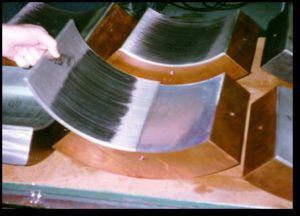Bearing failure mechanisms
There are literally dozens of ways bearings can fail. Some of the more common include: • Babbitt fatigue • Babbitt wiping due to rotor to stator contact • Babbitt flow due to high operating temperatures • Foreign particle damage • Varnish build up • Electrostatic discharge damage (frosting) • Electromagnetic discharge damage (Spark tracks) • Oil “burn” or additive plating due ot high temperatures • Loss of bond between babbitt and base metal • Chemical attack • Pivot wear in tilting pad bearings • Unloaded pad flutter • Cavitation damage
This is taken from a paper, Babbitted bearing health assessment" by John Whalen of John Crane, Thomas Hess of Rotating Machinery Group, Jim Allen of Nova Chemicals Corporation and Jack Craighton of Schneider Electric.

Loss of bond with copper pads[/caption]
Babbitt fatigue is caused by dynamic loads on the babbitt surface. Typically in bearings of this type the dynamic loads are caused by vibration and result in peak film pressure fluctuations. Cracks initiate on the babbitt surface and propagate radially towards the bond line. As the cracks get closer to the bond line the strength of the backing material reinforces the babbitt and causes the cracks to turn and spread circumferentially, meeting with other cracks and dislodging pieces of babbitt. A close up of the babbitt surface shows portions of babbitt missing and a section showing only surface cracks.
Babbitt fatigue strength can be increased by utilizing thinner babbitt (to take advantage of the backing material strength) and by keeping the babbitt temperature low. Obviously for a running machine changing babbitt thickness is not an option, but taking steps to reduce temperature and vibration often times are available.
Loss of bond between babbitt and base metal
This is most common when babbitt is applied to copper alloy. Copper is used extensively to reduce bearing operating temperatures by allowing a significantly increased heat transfer coefficient. Most bearing companies use a copper alloy that has good stiffness and strength while still having good heat transfer properties.
Loss of bond with copper pads
It has been discovered that copper has a strong affinity for tin and this is magnified at elevated temperatures. When babbitt is applied to bearings the process includes a tinning operation so the tin adheres to the base metal and then the babbitt bonds to the tin. Should the tin diffuse into the copper the bond will become weaker and weaker, and brittle. Oddly enough this is often times not discovered during normal NDT inspection (such as visual, PT or UT) since the bond is intact, it is just compromised and measures of bond strength are destructive. It has been discovered that applying a barrier layer prior to babbitting can eliminate this issue. A material must be selected that has good bond strength to copper and the tin will adhere to, while providing a barrier to tin migration into the copper. This failure mode is not possible to predict with conventional condition monitoring tools. As such the best way to address this issue is to verify the copper backed bearings, new or repaired, have a proven barrier layer. If there is a question as to whether the barrier layer exists it is recommended that during the next outage this is addressed. Also while the primary authors company has seen dozens of bearings that have had this problem none of them have failed in service; it is theorized that the brittle bond is not challenged during normal operation.
Electrostatic discharge
As mentioned earlier it is known that rotors can build up a static charge and this charge will jump to ground through the easiest path available. Preferably grounding brushes are utilized and these brushes take the charge off the rotor to ground in a controlled way. If there are no grounding brushes or they are not working properly then this charge can go to ground through the location where the rotor is closest to a grounded stationary.
Thrust pad with electrostatic discharge damage
Note that with a bearing like this the point of minimum film thickness is typically on the upper trailing edge as shown, Note that the babbitt has been spark eroded away starting in the minimum film thickness corner and working its way down the pad, as the pad shape changes. This damage can be avoided by ensuring there is adequate grounding.
Pivot wear
Since pads in tilting pad journal and thrust bearings actually tilt they can exhibit damage at the pivot interface(s) that can affect the performance of the bearing.
Pivot wear
This damage can be avoided with a lower stress pivot design and/or control of vibration levels.
Oil coking
From time to time oil analysis may indicate that the oil is oxidizing and/or an additive package content is diminishing. This could also be accompanied by slight rotor position moves and is usually present when there are elevated temperatures.
Varnish
As mentioned earlier the formation of varnish on lubricated surfaces has increased over the last 15 years or so as the more highly refined Group II oils have been utilized. At first glance it may appear as though the damage is similar to coking but further analysis will show that varnish deposits can be found on any surface in contact with the oil, high temperatures and pressures are not required. Signs that you may be experiencing varnish deposits include rotor position changes (due to the deposits getting thicker) and temperature changes due to the insulating behavior of the deposits and the thickness of the deposits resulting in reduced clearances.

.png&w=3840&q=75)

.png&w=3840&q=75)



.png&w=3840&q=75)



.png&w=3840&q=75)









